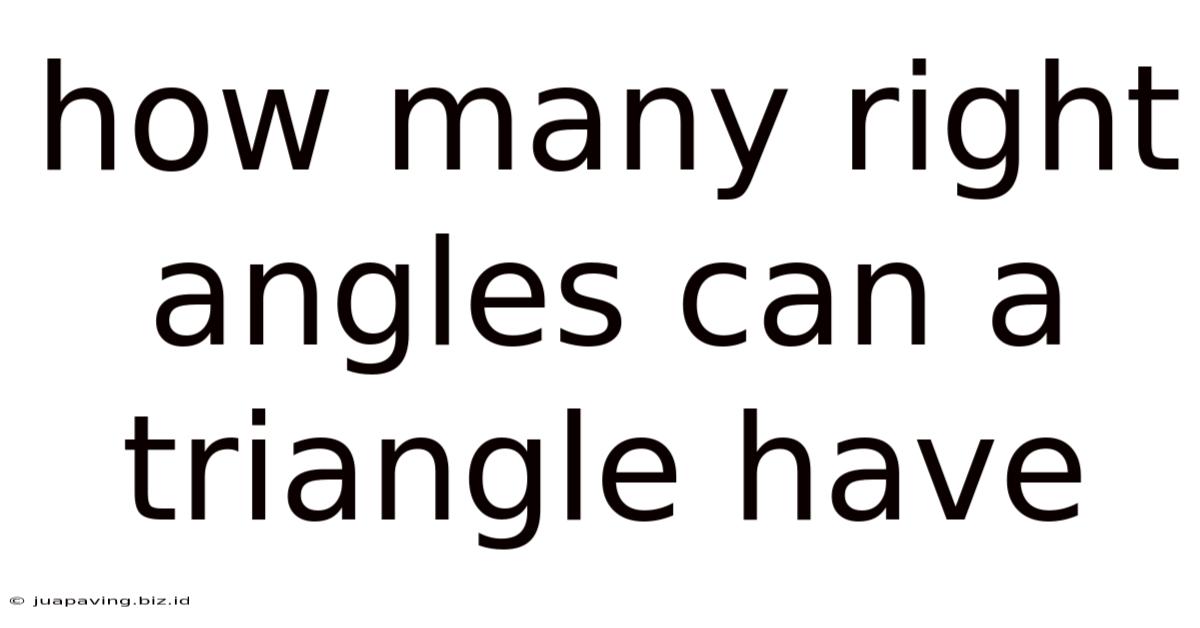How Many Right Angles Can A Triangle Have
Juapaving
May 11, 2025 · 4 min read

Table of Contents
How Many Right Angles Can a Triangle Have? Exploring the Geometry of Triangles
The question, "How many right angles can a triangle have?" seems deceptively simple. However, exploring this question allows us to delve into the fundamental principles of geometry, specifically the properties of triangles and the angles within them. The answer, as we'll see, is surprisingly definitive and leads to a deeper understanding of geometric shapes.
Understanding Triangles: A Foundation in Geometry
Before we tackle the core question, let's solidify our understanding of triangles. A triangle is a two-dimensional geometric shape defined by three sides and three angles. These angles are formed where the three sides meet at vertices. The sum of the interior angles of any triangle, regardless of its shape or size, always equals 180 degrees. This is a fundamental theorem in geometry, and its implications are crucial to understanding the limitations on the number of right angles a triangle can possess.
Types of Triangles Based on Angles:
Triangles are categorized based on their angles:
- Acute Triangle: All three angles are less than 90 degrees.
- Right Triangle: One angle is exactly 90 degrees (a right angle).
- Obtuse Triangle: One angle is greater than 90 degrees.
The Impossibility of Multiple Right Angles in a Triangle
Now, let's return to the central question: How many right angles can a triangle have? The answer is unequivocally one. This stems directly from the 180-degree sum of interior angles.
Let's explore why:
Imagine a triangle with two right angles. If two angles are 90 degrees each, their sum is already 180 degrees (90 + 90 = 180). However, a triangle must have three angles. This means the third angle would have to measure 0 degrees, which is impossible in a geometric sense. A 0-degree angle would imply that two sides of the triangle are collinear, essentially collapsing the triangle into a straight line. A true triangle requires three distinct sides forming a closed shape.
Similarly, a triangle cannot have three right angles. The sum of three 90-degree angles would be 270 degrees (90 + 90 + 90 = 270), far exceeding the 180-degree limit for the interior angles of any triangle.
Therefore, the maximum number of right angles a triangle can have is strictly limited to one. Any attempt to create a triangle with more than one right angle inherently violates the fundamental rule of the 180-degree angle sum.
Exploring Right-Angled Triangles: A Deeper Dive
The unique properties of right-angled triangles make them crucial in various fields, including:
-
Trigonometry: Right-angled triangles are the cornerstone of trigonometry, enabling the calculation of angles and side lengths using trigonometric functions like sine, cosine, and tangent. These functions are widely applied in surveying, navigation, and engineering.
-
Pythagorean Theorem: The Pythagorean theorem, a fundamental concept in geometry, applies exclusively to right-angled triangles. It states that the square of the hypotenuse (the side opposite the right angle) is equal to the sum of the squares of the other two sides (the legs). This theorem has numerous practical applications in construction, architecture, and various other fields.
-
Coordinate Geometry: Right-angled triangles are foundational to coordinate geometry, enabling us to calculate distances, slopes, and other geometric properties within a coordinate system. This is crucial in areas such as computer graphics and geographic information systems (GIS).
Special Right-Angled Triangles:
Within the category of right-angled triangles, we find some special cases:
-
45-45-90 Triangle (Isosceles Right Triangle): This triangle has two equal angles of 45 degrees each and a right angle of 90 degrees. Its sides are in a ratio of 1:1:√2.
-
30-60-90 Triangle: This triangle has angles of 30, 60, and 90 degrees. Its sides are in a ratio of 1:√3:2.
These special triangles are frequently encountered in geometric problems and have specific properties that simplify calculations.
Applications of Right-Angled Triangles: Real-World Examples
The applications of right-angled triangles extend far beyond the realm of theoretical geometry. They are essential tools in numerous fields:
-
Construction and Architecture: Calculating angles, determining distances, and ensuring structural integrity often rely on the principles of right-angled triangles.
-
Surveying and Mapping: Surveyors use right-angled triangles to measure distances and elevations, creating accurate maps and land surveys.
-
Navigation: Determining positions, calculating distances, and plotting courses often involve the application of trigonometry and right-angled triangles.
-
Physics and Engineering: Many physics calculations, particularly those involving forces, motion, and vectors, utilize right-angled triangles and trigonometric functions.
-
Computer Graphics and Game Development: The rendering of three-dimensional objects and the calculations of positions and movements in games often rely on the principles of right-angled triangles.
Conclusion: The Uniqueness of the Right-Angled Triangle
The question of how many right angles a triangle can have leads us to a fundamental truth in geometry: a triangle can only have one right angle. This limitation arises directly from the 180-degree sum of interior angles in any triangle. Understanding this limitation solidifies our understanding of basic geometric principles and highlights the importance and uniqueness of right-angled triangles in various fields, from theoretical mathematics to practical applications in engineering and technology. The seemingly simple question opens the door to a fascinating exploration of geometry, its theorems, and its real-world relevance.
Latest Posts
Latest Posts
-
How Many Feet Is 196 In
May 11, 2025
-
Whats The Square Root Of 343
May 11, 2025
-
Positive Words To Describe A Daughter
May 11, 2025
-
What Is The Rate Of Doing Work
May 11, 2025
-
What Statement Is True Of Eukaryotic Chromosomes
May 11, 2025
Related Post
Thank you for visiting our website which covers about How Many Right Angles Can A Triangle Have . We hope the information provided has been useful to you. Feel free to contact us if you have any questions or need further assistance. See you next time and don't miss to bookmark.